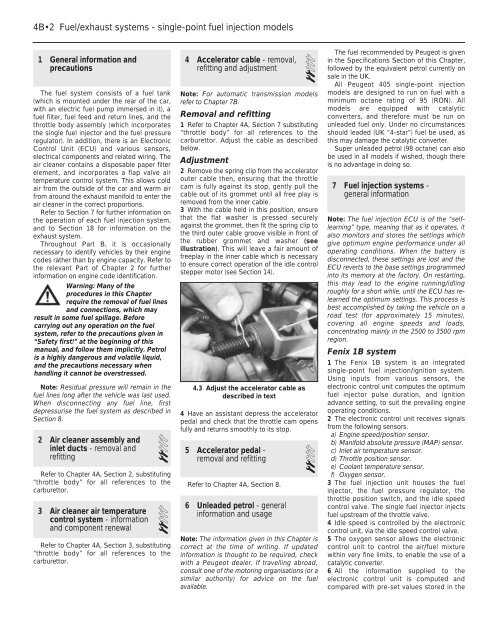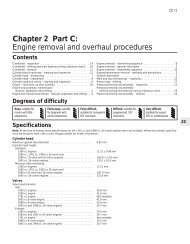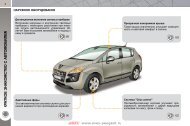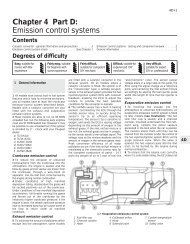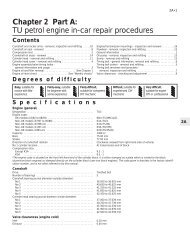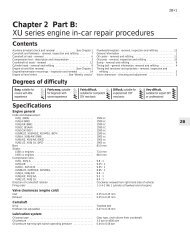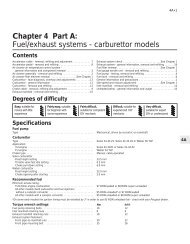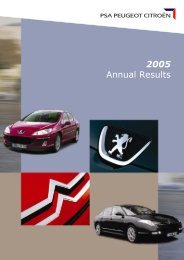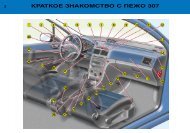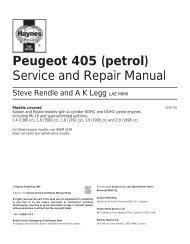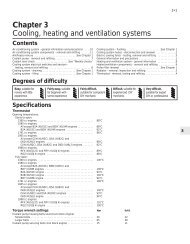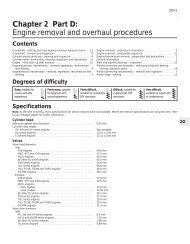4B•2 <strong>Fuel</strong>/<strong>exhaust</strong> <strong>systems</strong> - <strong>single</strong>-<strong>point</strong> <strong>fuel</strong> <strong>injection</strong> models1 General information andprecautionsThe <strong>fuel</strong> system consists of a <strong>fuel</strong> tank(which is mounted under the rear of the car,with an electric <strong>fuel</strong> pump immersed in it), a<strong>fuel</strong> filter, <strong>fuel</strong> feed and return lines, and thethrottle body assembly (which incorporatesthe <strong>single</strong> <strong>fuel</strong> injector and the <strong>fuel</strong> pressureregulator). In addition, there is an ElectronicControl Unit (ECU) and various sensors,electrical components and related wiring. Theair cleaner contains a disposable paper filterelement, and incorporates a flap valve airtemperature control system. This allows coldair from the outside of the car and warm airfrom around the <strong>exhaust</strong> manifold to enter theair cleaner in the correct proportions.Refer to Section 7 for further information onthe operation of each <strong>fuel</strong> <strong>injection</strong> system,and to Section 18 for information on the<strong>exhaust</strong> system.Throughout <strong>Part</strong> B, it is occasionallynecessary to identify vehicles by their enginecodes rather than by engine capacity. Refer tothe relevant <strong>Part</strong> of <strong>Chapter</strong> 2 for furtherinformation on engine code identification.Warning: Many of theprocedures in this <strong>Chapter</strong>require the removal of <strong>fuel</strong> linesand connections, which mayresult in some <strong>fuel</strong> spillage. Beforecarrying out any operation on the <strong>fuel</strong>system, refer to the precautions given in“Safety first!” at the beginning of thismanual, and follow them implicitly. Petrolis a highly dangerous and volatile liquid,and the precautions necessary whenhandling it cannot be overstressed.Note: Residual pressure will remain in the<strong>fuel</strong> lines long after the vehicle was last used.When disconnecting any <strong>fuel</strong> line, firstdepressurise the <strong>fuel</strong> system as described inSection 8.2 Air cleaner assembly andinlet ducts - removal and 2refittingRefer to <strong>Chapter</strong> 4A, Section 2, substituting“throttle body” for all references to thecarburettor.3 Air cleaner air temperaturecontrol system - information 2and component renewalRefer to <strong>Chapter</strong> 4A, Section 3, substituting“throttle body” for all references to thecarburettor.4 Accelerator cable - removal,refitting and adjustment 2Note: For automatic transmission modelsrefer to <strong>Chapter</strong> 7B.Removal and refitting1 Refer to <strong>Chapter</strong> 4A, Section 7 substituting“throttle body” for all references to thecarburettor. Adjust the cable as describedbelow.Adjustment2 Remove the spring clip from the acceleratorouter cable then, ensuring that the throttlecam is fully against its stop, gently pull thecable out of its grommet until all free play isremoved from the inner cable.3 With the cable held in this position, ensurethat the flat washer is pressed securelyagainst the grommet, then fit the spring clip tothe third outer cable groove visible in front ofthe rubber grommet and washer (seeillustration). This will leave a fair amount offreeplay in the inner cable which is necessaryto ensure correct operation of the idle controlstepper motor (see Section 14).4.3 Adjust the accelerator cable asdescribed in text4 Have an assistant depress the acceleratorpedal and check that the throttle cam opensfully and returns smoothly to its stop.5 Accelerator pedal -removal and refitting 2Refer to <strong>Chapter</strong> 4A, Section 8.6 Unleaded petrol - generalinformation and usageNote: The information given in this <strong>Chapter</strong> iscorrect at the time of writing. If updatedinformation is thought to be required, checkwith a Peugeot dealer. If travelling abroad,consult one of the motoring organisations (or asimilar authority) for advice on the <strong>fuel</strong>available.The <strong>fuel</strong> recommended by Peugeot is givenin the Specifications Section of this <strong>Chapter</strong>,followed by the equivalent petrol currently onsale in the UK.All Peugeot 405 <strong>single</strong>-<strong>point</strong> <strong>injection</strong>models are designed to run on <strong>fuel</strong> with aminimum octane rating of 95 (RON). Allmodels are equipped with catalyticconverters, and therefore must be run onunleaded <strong>fuel</strong> only. Under no circumstancesshould leaded (UK “4-star”) <strong>fuel</strong> be used, asthis may damage the catalytic converter.Super unleaded petrol (98 octane) can alsobe used in all models if wished, though thereis no advantage in doing so.7 <strong>Fuel</strong> <strong>injection</strong> <strong>systems</strong> -general informationNote: The <strong>fuel</strong> <strong>injection</strong> ECU is of the “selflearning”type, meaning that as it operates, italso monitors and stores the settings whichgive optimum engine performance under alloperating conditions. When the battery isdisconnected, these settings are lost and theECU reverts to the base settings programmedinto its memory at the factory. On restarting,this may lead to the engine running/idlingroughly for a short while, until the ECU has relearnedthe optimum settings. This process isbest accomplished by taking the vehicle on aroad test (for approximately 15 minutes),covering all engine speeds and loads,concentrating mainly in the 2500 to 3500 rpmregion.Fenix 1B system1 The Fenix 1B system is an integrated<strong>single</strong>-<strong>point</strong> <strong>fuel</strong> <strong>injection</strong>/ignition system.Using inputs from various sensors, theelectronic control unit computes the optimum<strong>fuel</strong> injector pulse duration, and ignitionadvance setting, to suit the prevailing engineoperating conditions.2 The electronic control unit receives signalsfrom the following sensors.a) Engine speed/position sensor.b) Manifold absolute pressure (MAP) sensor.c) Inlet air temperature sensor.d) Throttle position sensor.e) Coolant temperature sensor.f) Oxygen sensor.3 The <strong>fuel</strong> <strong>injection</strong> unit houses the <strong>fuel</strong>injector, the <strong>fuel</strong> pressure regulator, thethrottle position switch, and the idle speedcontrol valve. The <strong>single</strong> <strong>fuel</strong> injector injects<strong>fuel</strong> upstream of the throttle valve.4 Idle speed is controlled by the electroniccontrol unit, via the idle speed control valve.5 The oxygen sensor allows the electroniccontrol unit to control the air/<strong>fuel</strong> mixturewithin very fine limits, to enable the use of acatalytic converter.6 All the information supplied to theelectronic control unit is computed andcompared with pre-set values stored in the
<strong>Fuel</strong>/<strong>exhaust</strong> <strong>systems</strong> - <strong>single</strong>-<strong>point</strong> <strong>fuel</strong> <strong>injection</strong> models 4B•3module memory, to determine the requiredperiod of <strong>injection</strong>.7 The electronic control unit constantly variesthe <strong>fuel</strong> mixture, engine idle speed, andignition timing to provide optimum engineefficiency under all operating conditions, andto reduce <strong>exhaust</strong> gas emissions. The mixturestrength is accurately controlled to maintain itwithin the operating limits of the catalyticconverter.Bosch Mono<strong>point</strong> MA3.0 system8 The Bosch Mono<strong>point</strong> MA3.0 enginemanagement (<strong>fuel</strong> <strong>injection</strong>/ignition) systemincorporates a closed-loop catalytic converterand an evaporative emission control system,and complies with the latest emission controlstandards. The system operates as follows.9 The <strong>fuel</strong> pump, immersed in the <strong>fuel</strong> tank,pumps <strong>fuel</strong> from the <strong>fuel</strong> tank to the <strong>fuel</strong>injector, via a filter mounted underneath therear of the vehicle. <strong>Fuel</strong> supply pressure iscontrolled by the pressure regulator in thethrottle body assembly. The regulatoroperates by allowing excess <strong>fuel</strong> to return tothe tank.10 The electrical control system consists ofthe ECU, along with the following sensors.a) Throttle potentiometer - informs the ECUof the throttle position, and the rate ofthrottle opening or closing.b) Coolant temperature sensor - informs theECU of engine temperature.c) Inlet air temperature sensor - informs theECU of the temperature of the air passingthrough the throttle body.d) Lambda sensor - informs the ECU of theoxygen content of the <strong>exhaust</strong> gases(explained in <strong>Part</strong> D of this <strong>Chapter</strong>).e) Microswitch (built into the idle speedstepper motor) - informs the ECU whenthe throttle valve is closed (ie when theaccelerator pedal is released).f) Crankshaft sensor - informs the ECU ofengine speed and crankshaft positiong) Vehicle speed sensor (fitted to thegearbox) - informs the ECU of road speed.11 All the above information is analysed bythe ECU and, based on this, the ECUdetermines the appropriate ignition and<strong>fuel</strong>ling requirements for the engine. The ECUcontrols the <strong>fuel</strong> injector by varying its pulsewidth - the length of time the injector is heldopen - to provide a richer or weaker mixture,as appropriate. The mixture is constantlyvaried by the ECU, to provide the best settingfor cranking, starting (with either a hot or coldengine), warm-up, idle, cruising, andacceleration. Refer to <strong>Chapter</strong> 5 for furtherinformation on the ignition system.12 The ECU also has full control over theengine idle speed, via a stepper motor whichis fitted to the throttle body. The motorpushrod rests against a cam on the throttlevalve spindle. When the throttle valve isclosed, the ECU uses the motor to vary theopening of the throttle valve and so controlsthe idle speed.13 The ECU also controls the <strong>exhaust</strong> andevaporative emission control <strong>systems</strong>, whichare described in <strong>Part</strong> D of this <strong>Chapter</strong>.14 If there is an error in any of the readingsobtained from either the coolant temperaturesensor, the inlet air temperature sensor or thelambda sensor, the ECU enters its back-upmode. In this event, the ECU ignores theabnormal sensor signal, and assumes a preprogrammedvalue which will allow the engineto continue running (albeit at reducedefficiency). If the ECU enters this back-upmode, the warning light on the instrumentpanel will come on, and the relevant faultcode will be stored in the ECU memory.15 If the warning light comes on, the vehicleshould be taken to a Peugeot dealer at theearliest opportunity. A complete test of theengine management system can then becarried out, using a special electronicdiagnostic test unit which is simply pluggedinto the system’s diagnostic connector.Magneti Marelli G5and G6 <strong>systems</strong>16 A Magneti Marelli engine management(<strong>fuel</strong> <strong>injection</strong>/ignition) system is fitted to1580 cc XU5 engines.17 The <strong>fuel</strong> <strong>injection</strong> side of the systemoperates as described in the followingparagraphs. Refer to <strong>Chapter</strong> 5 for informationon the ignition side of the system.18 The <strong>fuel</strong> pump, immersed in the <strong>fuel</strong> tank,pumps <strong>fuel</strong> from the <strong>fuel</strong> tank to the <strong>fuel</strong>injector, via a filter. <strong>Fuel</strong> supply pressure iscontrolled by the pressure regulator in thethrottle body assembly. The regulatoroperates by allowing excess <strong>fuel</strong> to return tothe tank. To reduce emissions and to improvedriveability when the engine is cold, enginecoolant is passed through the manifold andaround the throttle body assembly.19 The electrical control system consists ofthe ECU, along with the following sensors.a) Manifold absolute pressure (MAP) sensor- informs the ECU of the load on theengine (expressed in terms of inletmanifold vacuum).b) Crankshaft sensor - informs the ECU ofthe crankshaft position and engine speed.c) Throttle potentiometer - informs the ECUof the throttle position, and the rate ofthrottle opening/closing.d) Coolant temperature sensor - informs theECU of the engine temperature.e) <strong>Fuel</strong>/air mixture temperature sensor -informs the ECU of the <strong>fuel</strong>/air mixturecharge temperature entering the engine.f) Lambda (oxygen) sensor - informs theECU of the oxygen content of the <strong>exhaust</strong>gases (explained in greater detail in <strong>Part</strong> Dof this <strong>Chapter</strong>).20 In addition, the ECU senses batteryvoltage (adjusting the injector pulse width tosuit, and using the stepper motor to increasethe idle speed and, therefore, the alternatoroutput if the voltage is too low). Short-circuitprotection and diagnostic capabilities areincorporated into the ECU, and it can bothreceive and transmit information via theengine management circuit diagnosticconnector, thus permitting engine diagnosisand tuning by special diagnostic equipment.21 All the above signals are compared by theECU, using digital techniques, with set valuespre-programmed (mapped) into its memory.Based on this information, the ECU selectsthe response appropriate to those values andcontrols the ignition HT coil (see <strong>Chapter</strong> 5),and the <strong>fuel</strong> injector (varying its pulse width -the length of time the injector is held open - toprovide a richer or weaker mixture, asappropriate). The mixture, idle speed andignition timing are constantly varied by theECU, to provide the best settings for cranking,starting (with either a hot or cold engine),warm-up, idle, cruising and acceleration.22 The ECU regulates the engine idle speedvia a stepper motor which is fitted to thethrottle body. The motor has a pushrodcontrolling the opening of an air passagewhich bypasses the throttle valve. When thethrottle valve is closed, the ECU controls themovement of the motor pushrod, whichregulates the amount of air which flowsthrough the throttle body passage, and socontrols the idle speed. The bypass passageis also used as an additional air supply duringcold starting.23 The ECU also controls the <strong>exhaust</strong> andevaporative emission control <strong>systems</strong>, whichare described in <strong>Part</strong> D of this <strong>Chapter</strong>.24 If there is an error in any of the readingsobtained from any of the engine managementcircuit sensors, the ECU enters its back-upmode. In this event, the ECU ignores theabnormal sensor signal, and assumes a preprogrammedvalue which will allow the engineto continue running (albeit at reducedefficiency). On entering this back-up mode,the engine management warning light in theinstrument panel will come on, informing thedriver of the fault, and the relevant fault codewill be stored in the ECU memory.25 If the warning light comes on, the vehicleshould be taken to a Peugeot dealer at theearliest opportunity. A complete test of theengine management system can then becarried out, using a special electronicdiagnostic test unit which is simply pluggedinto the system’s diagnostic connector.8 <strong>Fuel</strong> <strong>injection</strong> system -depressurisation2Note: Refer to the warning note in Section 1before proceeding.Warning: The followingprocedure will merely relievethe pressure in the <strong>fuel</strong> system -remember that <strong>fuel</strong> will still bepresent in the system components, andtake precautions accordingly beforedisconnecting any of them.4B


